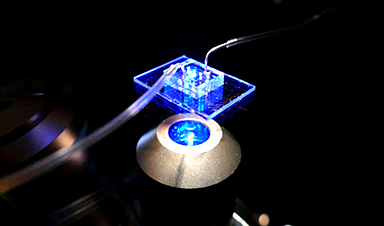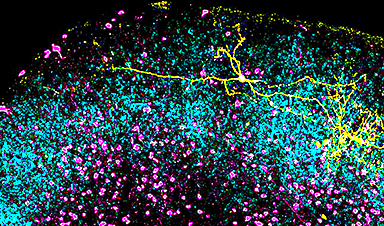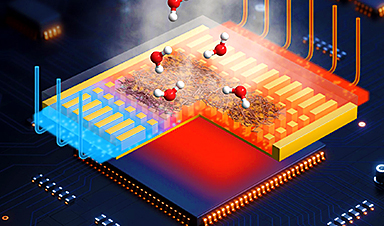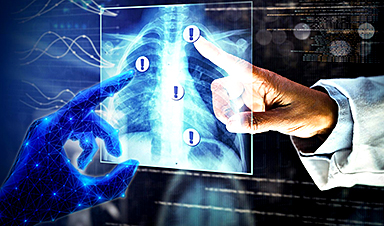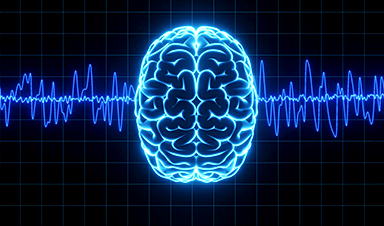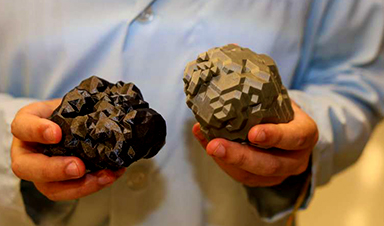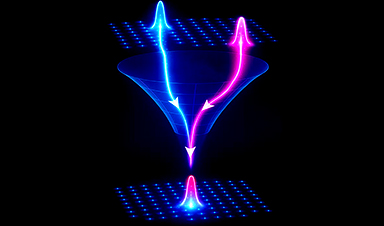Longer-Term Projects

Vascular Cartographic Scanning Nanodevice (VCSN)
Frank Boehm’s book Nanomedical Device and Systems Design, Challenges, Possibilities, Visions endeavors to explore and present concepts for advanced nanomedical components, devices, and systems that may emerge over the next ~10-30 years. One of these nanodevices is called the Vascular Cartographic Scanning Nanodevice (VCSN) (Figure 1), which would be manifest as an autonomous, ~1 micron in diameter nanomedical device.
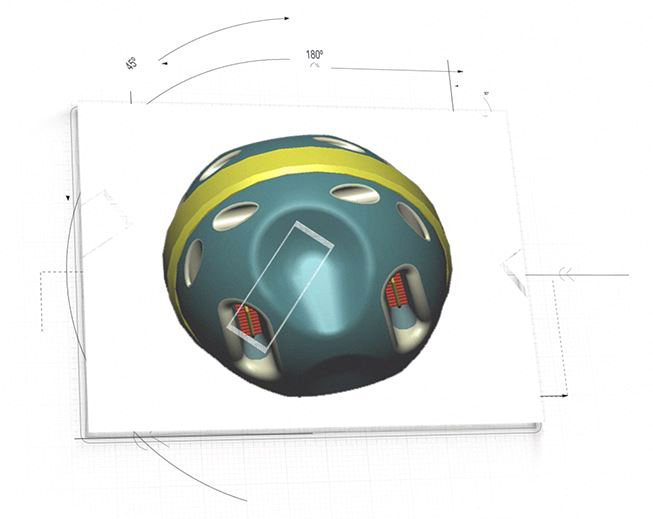
Figure 1: Artistic representation of conceptual Vascular Cartographic Scanning Nanodevice (VCSN)
Up to perhaps many thousands, or tens of thousands of VCSN nanodevices might be introduced into the patient intravenously, via ingestion as a pill, through inhalation, transdermally using a patch, or migrate in vivo utilizing a topical gel. Once within the patient their purpose would be to rapidly scan the entire human vasculature down to the smallest capillary lumen (~3 microns in diameter) in ultrahigh-resolution (sub-micron) three-dimensional (3D) digitized format. At all times they would be under the complete control of the surgeon or physician via “outbody” computer commands. Some of the capabilities of the VCSN are listed below:
- Capable of generating a very high-resolution (under 1 micron) 3D rendering of the complete human vasculature down to the smallest capillaries. It may also be applied to the imaging of the lymphatic system, and in a simplified form, the gastrointestinal tract, using a Gastrointestinal Micro Scanning Device (GMSD), (see description below).
- Ability to distinguish vascular and neurological plaque deposits and lesions with high accuracy.
- Capacity to determine vascular wall thicknesses, along with the identification and highlighting of any “hot spot” sites within the vasculature, such as imminent blockages or aneurysms that are at risk of rupturing.
- Surgeon and physicians would be able to “fly-through” all scanned areas via a joystick and computer display for the highly detailed inspection of any desired site within the system. The acquired spatial data from the VCSN may also enable holographic rendering and virtual travel through all imaged systems.
- Ability to facilitate the targeting of tumors by revealing sites of angiogenesis in close proximity to tumor growth sites.
A number of advantages of the VCSN include:
- High compactness and portability as its operation will require a relatively small footprint. This would enable a simple and quick setup and power-up procedures, which will be a boon for applications in developing countries and remote terrestrial environments.In aerospace, it might be utilized as an element of an on board medical diagnostics suite on military and medical aircraft.
- For space travel, it may be reconfigured for integration into spacesuits and spacecraft, and provide a compact yet very powerful medical imaging capability for future Moon and Mars habitats.
- Frugal energy consumption.
- Inexpensive administration and operation
- Rapid scanning time (~5 minutes).
- Ultrahigh resolution digital imagery and inherent flexibility for display across several formats and ease of file transmission to medical personnel globally via secure telecommunications connectivity
- Potential for enabling the significant reduction or elimination of long waiting queues for critical imaging technologies.
Gastrointestinal Micro Scanning Device (GMSD)
The Gastrointestinal Micro Scanning Device (GMSD) (Figure 2) will serve as far less complex precursor to the VCSN as it will not have the capacity for propulsion or navigation. It might, however, employ nascent forms of quantum computing, nanoelectronics, spatial data acquisition, and Pixel Matrix (see below) technologies that are envisaged for the VCSN. Hence, in addition to serving as formative in vivo spatial data acquisition device, the GMSD may also have utility as a test bed of sorts that is employed to identify and resolve technical, integrative, and functional issues toward the development of the VCSN.
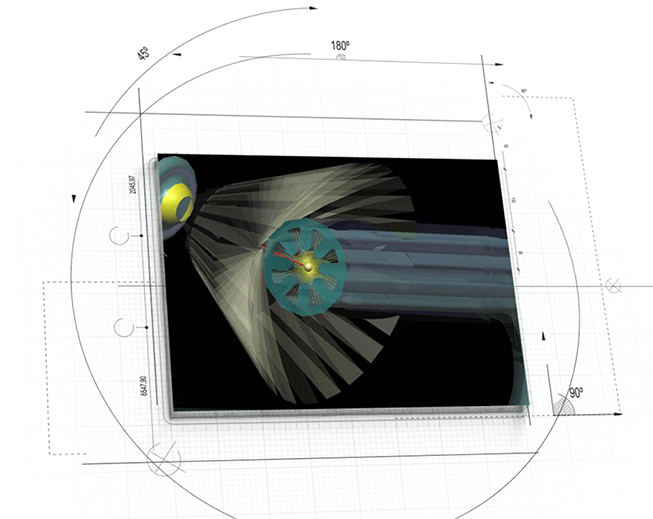
![]()
Figure 2: Artistic representation of conceptual Gastrointestinal Micro Scanning Device (GMSD)
The GMSD system will consist of three distinct components that work in unison to generate very high-resolution 3D topography of the entire internal surface of the GIT. The GMSD would accomplish this task by utilizing:
- Bright Ball (BB) scanning device, which would have a smooth spherical morphology of ~3 mm in diameter
- Pulse Generator/Data Transfer (PGDT) unit would trigger the activity of the internalized BB device via a specifically encrypted signal. The BB would be activated to scan subsequently to receiving this specific signal only. Once activated, the BB would commence to transmit a constant spatial data stream to the PGDT, which would serve as a data transfer device when linked to a computer and the Pixel Matrix (see below) software. The PGDT would be securely affixed to the patient’s abdominal surface and would stay in place for the duration of the scan.
- The Pixel Matrix display would process the PGDT supplied spatial data toward the reconstruction a high resolution “pixel per hit” 3D rendering of the total scanned area of the GIT that has been traversed by the BB. This software would enable “fly-through” and cross-sectional capabilities, allowing medical personnel to traverse the entire GIT (using a joystick, computer mouse, or touch screen display) to investigate any potential problem areas in great detail. The spatial data might also be converted to holographic and virtual reality formats. Using this procedure, the physician and/or surgeon would thus recognize any anomalous topography that is associated with tumor growth, lesions, and other abnormal features that may exist within the GIT.
The operational procedure for the GMSD would be relatively simple to implement, as the BB would be introduced orally to the patient in the same manner as a pill. Subsequently, an adhesive waterproof thin film PGDT patch would be affixed to the skin of patient’s abdomen. At this juncture, a system calibration would be performed to ensure that the communication link between the BB and the PGDT is functioning properly. An initial test scan would also be conducted in order to configure the image resolution. The PGDT would emit a unique pulsed signal (e.g., ultrasonic, near-infrared), which when received by sensors embedded within the surface of the BB would trigger all of the embedded emitters/receivers to fire and emit their scanning beams simultaneously in every direction. Once these procedures are completed the patient would be allowed to leave the physician’s office, clinic, or hospital to go about his/her normal routine. The internalized BB would now move along with the natural peristaltic rhythms of the GIT and be naturally eliminated at the conclusion of the transit duration. The patient would then return to the facility in two or three days (contingent on the assessed GIT transit time) to have the PGDT patch removed.
During the designated scanning period, the PGDT will have been continuously uploading spatial data provided by the BB, which would then be interfaced with a computer via a USB port to stream all of this data to the PM software housed within the computer. The data would now be translated to high-resolution 3D imagery on a display. The PM software would calculate BB orientation and would correlate the interrogating hits obtained within predetermined parameters to construct a cross section of the GIT to depict its internal topography. These digitized fragments would then be sequentially pieced together to form a seamless spatially accurate rendering of the system.
News
Lipid nanoparticles discovered that can deliver mRNA directly into heart muscle cells
Cardiovascular disease continues to be the leading cause of death worldwide. But advances in heart-failure therapeutics have stalled, largely due to the difficulty of delivering treatments at the cellular level. Now, a UC Berkeley-led [...]
The basic mechanisms of visual attention emerged over 500 million years ago, study suggests
The brain does not need its sophisticated cortex to interpret the visual world. A new study published in PLOS Biology demonstrates that a much older structure, the superior colliculus, contains the necessary circuitry to perform the [...]
AI Is Overheating. This New Technology Could Be the Fix
Engineers have developed a passive evaporative cooling membrane that dramatically improves heat removal for electronics and data centers Engineers at the University of California San Diego have created an innovative cooling system designed to greatly enhance [...]
New nanomedicine wipes out leukemia in animal study
In a promising advance for cancer treatment, Northwestern University scientists have re-engineered the molecular structure of a common chemotherapy drug, making it dramatically more soluble and effective and less toxic. In the new study, [...]
Mystery Solved: Scientists Find Cause for Unexplained, Deadly Diseases
A study reveals that a protein called RPA is essential for maintaining chromosome stability by stimulating telomerase. New findings from the University of Wisconsin-Madison suggest that problems with a key protein that helps preserve chromosome stability [...]
Nanotech Blocks Infection and Speed Up Chronic Wound Recovery
A new nanotech-based formulation using quercetin and omega-3 fatty acids shows promise in halting bacterial biofilms and boosting skin cell repair. Scientists have developed a nanotechnology-based treatment to fight bacterial biofilms in wound infections. The [...]
Researchers propose five key questions for effective adoption of AI in clinical practice
While Artificial Intelligence (AI) can be a powerful tool that physicians can use to help diagnose their patients and has great potential to improve accuracy, efficiency and patient safety, it has its drawbacks. It [...]
Advancements and clinical translation of intelligent nanodrugs for breast cancer treatment
A comprehensive review in "Biofunct. Mater." meticulously details the most recent advancements and clinical translation of intelligent nanodrugs for breast cancer treatment. This paper presents an exhaustive overview of subtype-specific nanostrategies, the clinical benefits [...]
It’s Not “All in Your Head”: Scientists Develop Revolutionary Blood Test for Chronic Fatigue Syndrome
A 96% accurate blood test for ME/CFS could transform diagnosis and pave the way for future long COVID detection. Researchers from the University of East Anglia and Oxford Biodynamics have created a highly accurate [...]
How Far Can the Body Go? Scientists Find the Ultimate Limit of Human Endurance
Even the most elite endurance athletes can’t outrun biology. A new study finds that humans hit a metabolic ceiling at about 2.5 times their resting energy burn. When ultra-runners take on races that last [...]
World’s Rivers “Overdosing” on Human Antibiotics, Study Finds
Researchers estimate that approximately 8,500 tons of antibiotics enter river systems each year after passing through the human body and wastewater treatment processes. Rivers spanning millions of kilometers across the globe are contaminated with [...]
Yale Scientists Solve a Century-Old Brain Wave Mystery
Yale scientists traced gamma brain waves to thalamus-cortex interactions. The discovery could reveal how brain rhythms shape perception and disease. For more than a century, scientists have observed rhythmic waves of synchronized neuronal activity [...]
Can introducing peanuts early prevent allergies? Real-world data confirms it helps
New evidence from a large U.S. primary care network shows that early peanut introduction, endorsed in 2015 and 2017 guidelines, was followed by a marked decline in clinician-diagnosed peanut and overall food allergies among [...]
Nanoparticle blueprints reveal path to smarter medicines
Lipid nanoparticles (LNPs) are the delivery vehicles of modern medicine, carrying cancer drugs, gene therapies and vaccines into cells. Until recently, many scientists assumed that all LNPs followed more or less the same blueprint, [...]
How nanomedicine and AI are teaming up to tackle neurodegenerative diseases
When I first realized the scale of the challenge posed by neurodegenerative diseases, such as Alzheimer's, Parkinson's disease and amyotrophic lateral sclerosis (ALS), I felt simultaneously humbled and motivated. These disorders are not caused [...]
Self-Organizing Light Could Transform Computing and Communications
USC engineers have demonstrated a new kind of optical device that lets light organize its own route using the principles of thermodynamics. Instead of relying on switches or digital control, the light finds its own [...]
Groundbreaking New Way of Measuring Blood Pressure Could Save Thousands of Lives
A new method that improves the accuracy of interpreting blood pressure measurements taken at the ankle could be vital for individuals who are unable to have their blood pressure measured on the arm. A newly developed [...]
Scientist tackles key roadblock for AI in drug discovery
The drug development pipeline is a costly and lengthy process. Identifying high-quality "hit" compounds—those with high potency, selectivity, and favorable metabolic properties—at the earliest stages is important for reducing cost and accelerating the path [...]
Nanoplastics with environmental coatings can sneak past the skin’s defenses
Plastic is ubiquitous in the modern world, and it's notorious for taking a long time to completely break down in the environment - if it ever does. But even without breaking down completely, plastic [...]
Chernobyl scientists discover black fungus feeding on deadly radiation
It looks pretty sinister, but it might actually be incredibly helpful When reactor number four in Chernobyl exploded, it triggered the worst nuclear disaster in history, one which the surrounding area still has not [...]
